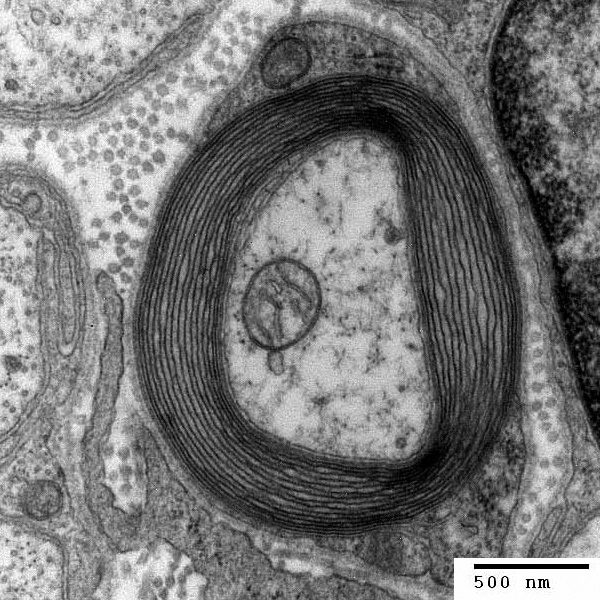US researchers have shown that stem cells can be used to replace the myelin coating that surrounds brain cells and is attacked by diseases like MS.
 Writing in this month's edition of the journal Cell Stem Cell Rochester University's Steve Goldman and his colleagues injected new-born mice with 300,000 human brain cells at various places in their nervous systems. These animals, known as "shiverer mice", carry a genetic mutation that causes the breakdown of a substance in their brains called myelin, which normally surrounds nerve fibres and acts like an insulator to help with the transmission of nerve impulses. The animals develop neurological symptoms, including limb weakness and seizures, within a month or two of being born and usually do not survive longer than 130 days. But amongst the animals treated with the stem cells, although all of them initially became symptomatic, 25% recovered and were effectively cured, surviving until the end of the experiments over 1 year later.
Writing in this month's edition of the journal Cell Stem Cell Rochester University's Steve Goldman and his colleagues injected new-born mice with 300,000 human brain cells at various places in their nervous systems. These animals, known as "shiverer mice", carry a genetic mutation that causes the breakdown of a substance in their brains called myelin, which normally surrounds nerve fibres and acts like an insulator to help with the transmission of nerve impulses. The animals develop neurological symptoms, including limb weakness and seizures, within a month or two of being born and usually do not survive longer than 130 days. But amongst the animals treated with the stem cells, although all of them initially became symptomatic, 25% recovered and were effectively cured, surviving until the end of the experiments over 1 year later.
Tests on their brains showed that the 300,000 injected stem cells had multiplied to over 12 million and spread almost throughout the entire nervous system, taking over the role of the animals' own cells that were being lost to their disease. Nerves in the repaired brains also seemed to be conducting impulses at the correct speeds (and twice as fast as those from diseased untreated animals), indicating that the stem cells were re-myelinating the damaged brain.
The results are very encouraging because there are a number of human brain conditions very similar to the disease developed by the shiverer mouse, suggesting that the same neurological repair trick might be possible in us. The researchers also point out that cerebral palsy is also a consequence of damage to myelin triggered by low oxygen exposure, and this condition too might be amenable to this sort of therapy.
The present downside is that the stem cells used in these experiment were obtained by purifying brain tissue extracts from aborted human foetuses, which some find morally objectionable. But more importantly, these cells are likely to be recognised as foreign by the immune system, a problem side-stepped in this study by using mice with an immune deficiency.










Comments
Add a comment